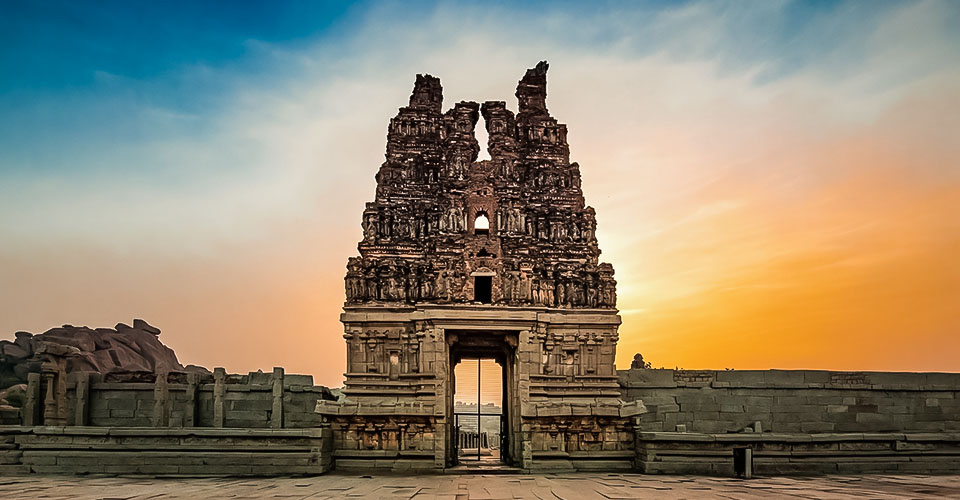Introduction:
The famous Hampi Krishna Temple is located in the centre of the historic city of Hampi, amid the magnificent ruins of the Vijayanagara Empire. In addition to its religious significance, this architectural wonder honouring Lord Krishna also serves as a reminder of Hampi’s rich cultural and historical heritage.
Hampi Krishna Temple:
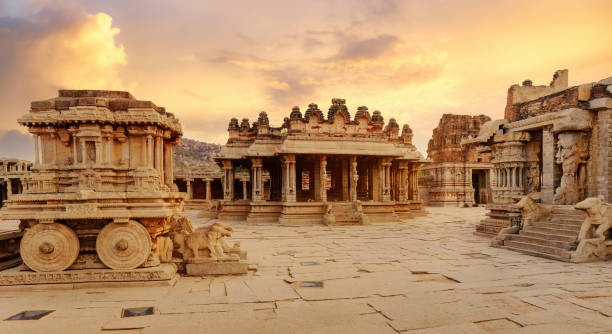
A fascinating example of ancient India’s rich cultural and architectural legacy is the Hampi Krishna Temple. Lord Krishna, a prominent figure in Hindu mythology, is the subject of this temple complex, which is situated in Hampi, a UNESCO World Heritage site in Karnataka.
Upon entering the temple premises, you will be captivated by the exquisite engravings that decorate the walls and pillars. These intricately carved representations of Hindu mythology include tales of gods, goddesses, and epic tales. The amazing craftsmanship demonstrates the abilities of the artists who created magnificent works of art out of stone.
The Krishna Temple Complex has a calm, spiritual environment that is evidently infused with holy energy. The temple’s opulence and meticulous attention to detail are hallmarks of the Vijayanagara architectural style. The center of the complex is the main sanctuary, which is devoted to Lord Krishna and radiates a feeling of heavenly energy.
You can fully immerse yourself in the site’s cultural and religious significance by exploring the temple grounds. As a testament to devotion, creativity, and the continuing legacy of ancient Indian civilization, the Hampi Krishna Temple survives today. It connects visitors to the spiritual essence of the past through a journey through time rather than just being a physical edifice.
- Historical Significance: During the Vijayanagara Empire’s rule in the 16th century, the Krishna Temple Complex, also called the Hampi Krishna Temple, flourished. It honours Lord Krishna while demonstrating the talent and commitment of the artisans of that time.
- Architectural Grandeur: The temple complex has a magnificent Dravidian architectural style, with magnificent sculptures, finely carved pillars, and a tall gopuram that welcomes guests with artistic magnificence. Both history buffs and devotees will find an immersive experience as the sculptures tell stories from Hindu mythology.
- Divine Sanctum: A calmness descends upon you as soon as you set foot on the temple grounds. The idol of Lord Krishna is kept in the sanctum sanctorum, where it is embellished with customary items and surrounded by worshippers. The echoes of centuries-old rites and worship fill the temple with spiritual vitality.
- Cultural Heritage: The Hampi Krishna Temple is a living archive of cultural heritage in addition to being a site of devotion. During the Vijayanagara Empire, the temple complex functioned as a hub for religious and cultural events, holding a variety of festivals, dance performances, and spiritual gatherings.
Hampi Temple:
Temples in Hampi, the former capital of the Vijayanagara Empire, serve as moving reflections of a bygone period. The city has a wealth of cultural and historical significance. Not only are the temples at Hampi remarkable pieces of architecture, but they also serve as living reminders of the vibrant culture that once called this ancient city home.
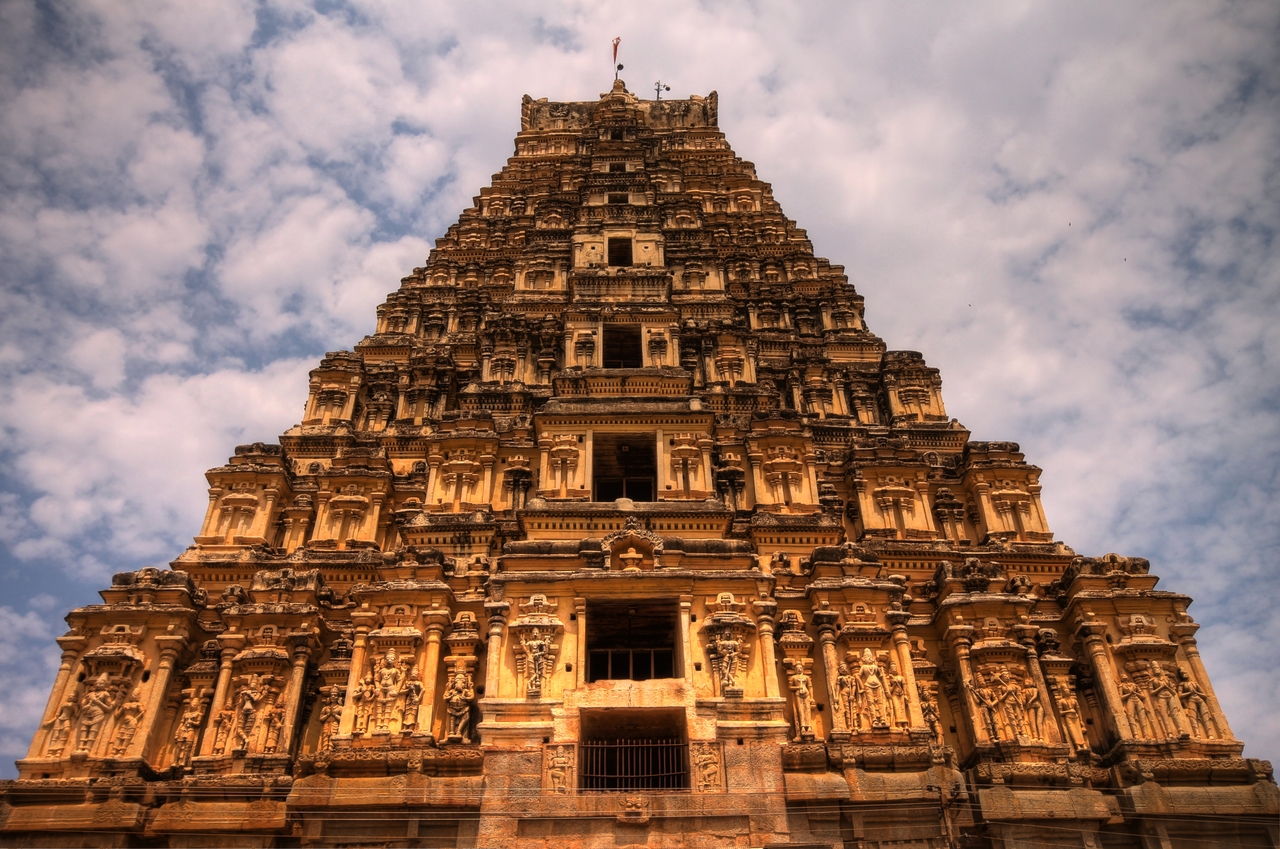
- Vijayanagara Empire: The majority of the temples in Hampi are built in the Vijayanagara architectural style, which reflects the opulence and creative genius of the Vijayanagara Empire. The empire, which ruled South India from the 14th to the 17th century, was crucial in forming the region’s religious and cultural milieu.
- Religious Diversity: The temples of Hampi are a perfect synthesis of many different religious influences. There are Jain temples, which illustrates the religious tolerance and inclusivity of the Vijayanagara monarchs, despite the fact that many are devoted to Hindu deities like Virupaksha, Krishna, and Virabhadra.
- Architectural marvels: With its elaborate carvings, soaring gopurams (entrance towers), and expansive complexes, the temples of Hampi exhibit amazing architectural techniques. One of the oldest still-existing temples in India is the Virupaksha Temple, which honours Lord Shiva.
- Cultural Hub: In addition to being places of worship, the temples functioned as gathering places for social and cultural events. They saw elaborate ceremonies, colourful processions, and celebrations that united the local communities.
History of Hampi:
The history of Hampi is a fascinating story that takes place in the shadow of the Vijayanagara state, a once-vibrant state. Discover the intricate historical history of this UNESCO World Heritage site by embarking on a voyage through time.
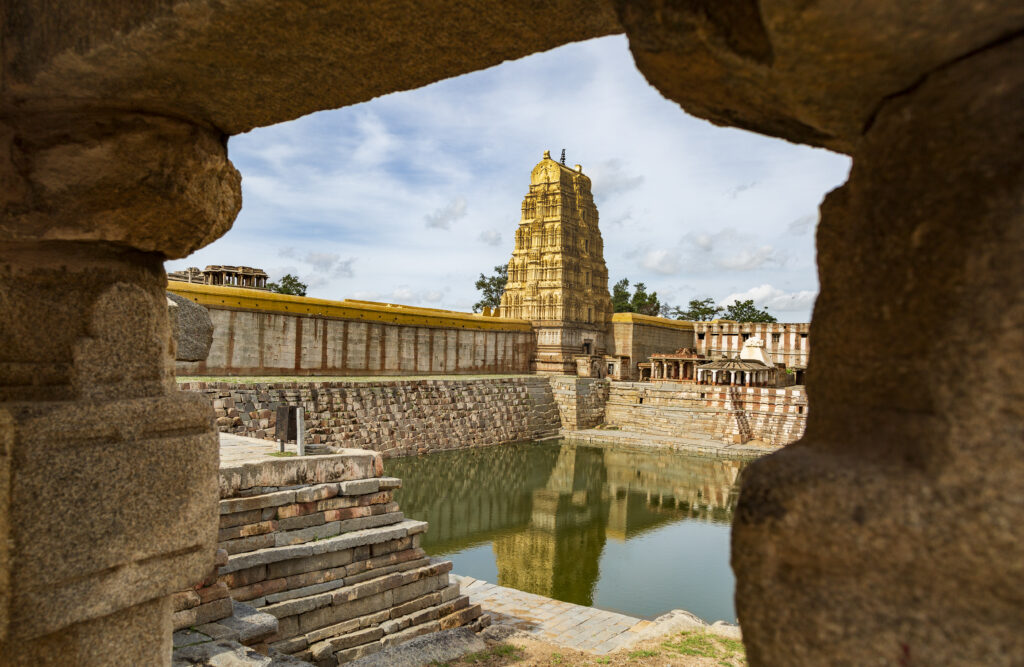
- Vijayanagara Empire Founding (1336 CE): The history of Hampi starts in the 14th century with the establishment of the Vijayanagara Empire by two brothers, Harihara and Bukka. Because of Hampi’s advantageous location, the empire—known for its strong military, thriving trade, and dynamic culture—selected it as its capital.
- Golden Period of Vijayanagara (14th to 16th century): Kings such as Krishna Deva Raya led the Vijayanagara Empire to its pinnacle of power. Hampi developed into a thriving commercial hub that drew traders from far-off places. With its thriving bazaars, palaces, and temples, the city was dubbed the “City of Victory.”
- Architectural marvels: The Vijayanagara dynasty’s mastery of architecture permanently altered the Hampi landscape. Grand temples like Virupaksha, Hazara Rama, and Vittala, with their elaborate carvings, imposing gopurams, and elaborate pillars, dot the city.
- Fall of Vijayanagara (1565 CE): In 1565, Hampi’s glorious history came to an abrupt halt when the city was soundly defeated at the Battle of Talikota. A large portion of Hampi was destroyed and pillaged by the Deccan Sultanates, which ultimately caused its collapse. The once-powerful empire fell, leaving Hampi in ruins.
- Rediscovery and Abandonment: After Hampi was sacked, the city was left deserted, and nature gradually took back its buildings. Before being rediscovered by British archaeologists in the 19th century, the ruins were kept secret from the general public. The discovery of Hampi’s rich archaeological record brought attention to the place’s historical and cultural significance.
- UNESCO World Heritage Site (1986): In 1986, Hampi received the UNESCO World Heritage Site designation in recognition of its extraordinary cultural significance. In addition to being a fascinating outdoor museum, the ruins of Hampi stand as a testament to the tenacity of a once-thriving civilization.
Hampi Temple History:
The history of the Hampi Temples: These architectural wonders are also the archives of enthralling tales that reverberate through the ages. Let’s examine the pasts of a few well-known Hampi temples:
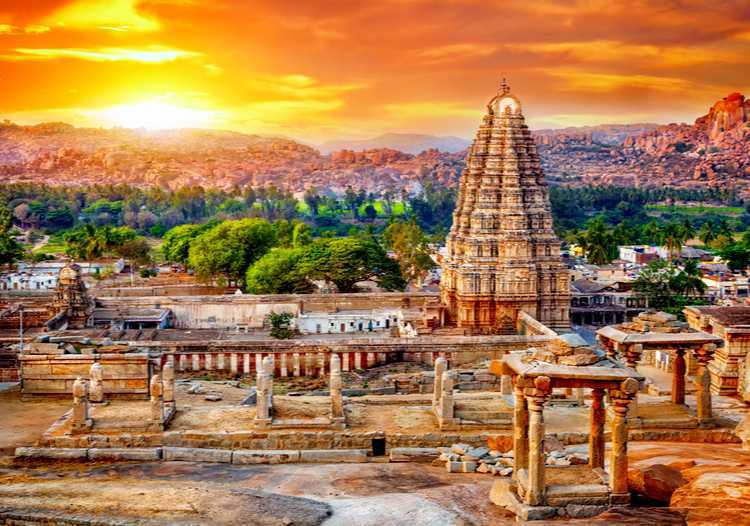
Temple of Virupaksha:
- History: The Virupaksha Temple is of great historical value and is the oldest temple still in operation in Hampi. It was first established in the seventh century, and the Chalukyas and Vijayanagara dynasties later expanded it.
- Architectural Highlights: Highlights of the architecture include the temple’s imposing gopuram (entry tower), elaborate carvings that represent Hindu mythological events, and a holy sanctuary where Lord Shiva in the form of Virupaksha is worshipped.
Temple Vittala:
- History: The famous Stone Chariot and its remarkable construction have made the Vittala Temple an iconic building. Constructed in the 16th century under Krishna Deva Raya’s rule, it was devoted to Lord Vittala, a manifestation of Lord Vishnu.
- Architectural Highlights: The temple complex is home to the renowned Stone Chariot, an exquisitely carved musical pillars hall, and incredibly elaborate Vijayanagara-style architecture.
Hazara Rama Temple:
- History: The Vijayanagara kings’ personal shrine was the Hazara Rama shrine, which was devoted to Lord Rama. King Devaraya II built it in the first half of the fifteenth century.
- Highlights of the Architecture: The temple is well-known for its beautiful bas-reliefs that tell the story of the Ramayana and show the life and exploits of Lord Rama. The term “Hazara Rama” signifies “a thousand Rama,” underscoring the abundance of intricate carvings.
Temple of Achyutaraya:
- History: The Achyutaraya Temple was erected in the sixteenth century by King Achyuta Raya and is devoted to Lord Tiruvengalanatha, a manifestation of Lord Vishnu.
- Architectural Highlights: The temple is well known for its magnificent entryway, finely carved pillars, and striking raya and kalyana mantapas. The magnificence of the Vijayanagara style is reflected in the building.
Krishna Temple Complex:
- History: Early in the 16th century, King Krishna Deva Raya constructed the Krishna Temple Complex, which is devoted to Lord Krishna.
- Architectural Highlights: The complex has intricately carved pillars, a captivating mandapa, and representations from the Mahabharata. The carvings tell the story of Lord Krishna’s adventures.
Places to Visit in Hampi:
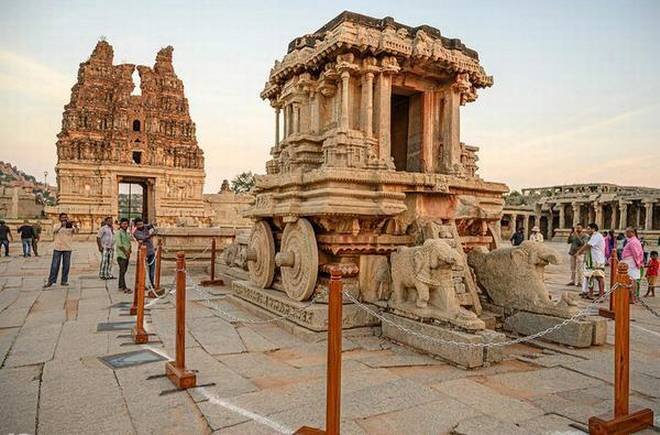
Discover the many sights that Hampi has to offer, such as the captivating Lotus Mahal, the breathtaking Vittala Temple, and the recognisable Virupaksha Temple. Every location reveals a new aspect of Hampi’s magnificent architectural design and rich past.The following are a few Hampi must-see locations:
- Virupaksha Temple: Lord Shiva’s temple, which is the oldest in Hampi still in operation. Admire the elaborate carvings, the tall gopuram, and the hallowed shrine that has seen centuries of devotion.
- Temple Vittala: Known for the Stone Chariot, its outstanding construction, and its melodic pillars. A visual feast for the senses is provided by the entire display of Vijayanagara classic grandeur.
- Hemakuta Hill: For sweeping views of the Hampi countryside, ascend Hemakuta Hill. The hill offers a calm environment for exploring and is lined with historic temples, such as the Veerabhadra Temple.
- Temple of Achyutaraya: Honouring Lord Tiruvengalanatha, this temple features elaborate carvings, a grand entryway, and striking raya and kalyana mantapas. It showcases the Vijayanagara Empire’s magnificent architectural design.
- Mahal Lotus: In the centre of the royal enclosure of Hampi lies an architectural marvel. The Lotus Mahal is renowned for fusing Islamic and Hindu architectural elements into a distinctive lotus-shaped design.
- Hazara Rama Temple: Take a tour of the Hazara Rama Temple, which features elaborate bas-reliefs on its walls that portray various Ramayana scenes. The translation of the name, “a thousand Rama,” highlights the abundance of carvings.
- Elephant Resting Places: Take in the majesty of the Elephant Stables, a distinctive building that provided the royal elephants with a somewhere to stay. The Indo-Islamic style is blended beautifully in the architecture.
- The Bath of the Queen: Take a tour of the magnificent Queen’s Bath, a swimming facility featuring a distinctive fusion of Islamic and Hindu architectural features. The domed ceilings and finely carved balconies attest to the luxury of the royal court.
- Matanga Hill: Climb Matanga Hill for amazing views of Hampi at sunrise or sunset. The hill provides a serene haven and is lined with historic temples, such as the Veerabhadra Temple.
- River Tungabhadra: Enjoy the panoramic splendour and the famous boulder-strewn topography that gives Hampi its distinct charm by taking a leisurely stroll along the Tungabhadra River.
Hampi Utsav:
The temple’s colourful celebrations are one of its highlights, notably during the yearly Hampi Utsav. The temple comes alive with processions, music, dance, and ceremonies during this festival, drawing both tourists and devotees to see the magnificence of the cultural spectacle.
Hampi Best Time to Visit:
Although the weather is lovely during the winter months (October to March), the November Hampi Utsav brings cultural energy. To determine the ideal time to visit, take into account your tastes and the schedule of the event.
Hampi Railway Station:
Take the easy approach and schedule your travel by taking the rail route. An additional means of transportation is the well-connected Hampi Railway Station, which connects to major cities. A quick guide to the Hampi Railway Station is provided below:
- Location: The closest town to Hampi is Hospet, which is home to the Hampi Railway Station.
- Connectivity: The station is a convenient choice for travellers since it has good connections to important destinations like Bangalore, Hyderabad, and Goa.
- Distance to Hampi: From the train station, it’s a short drive or easy to take local transportation to Hampi, which is around 13 kilometers away from Hospet.
- Train Services: A number of trains run to and from Hampi Railway Station, offering choices for all budgets and tastes in travel.
- Facilities: The railway station is equipped with basic facilities like waiting rooms, ticket counters, and amenities to make your journey comfortable.
Nearest Airport to Hampi:
For those flying in, the nearest airport to Hampi is Vidyanagar Airport. Explore hassle-free travel options and begin your Hampi adventure with ease.
Conclusion:
With its unique fusion of faith, history, and scenic beauty, Hampi beckons visitors on an enthralling voyage. This location offers an amazing experience whether you’re seeing historic temples, unwinding in tranquil resorts, or taking in the vibrant local culture during Hampi Utsav.
You may like reading about the following:
For more information, visit: Tech Crowd Media
